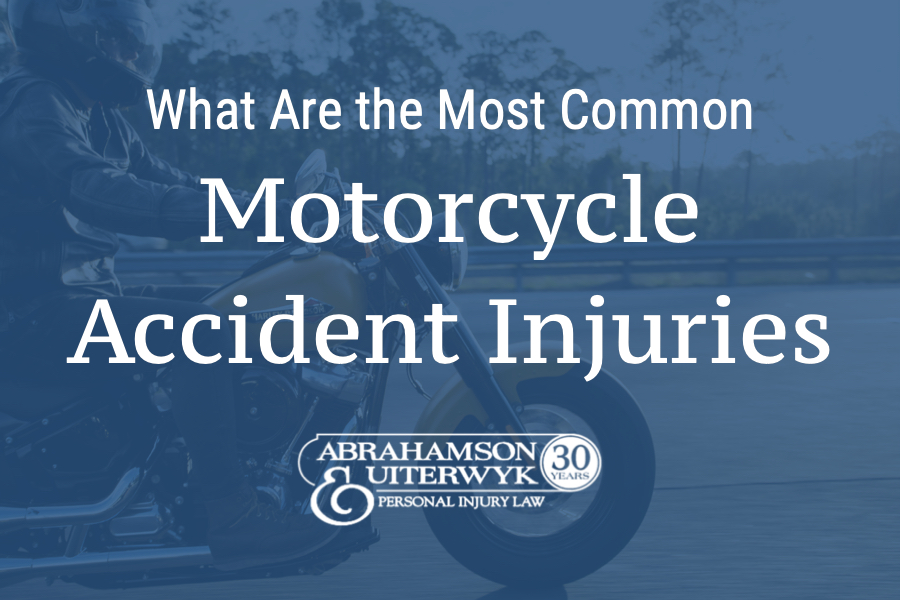Common Motorcycle Accident Injuries
Whether you choose to ride your motorcycle as a hobby or as a commuter vehicle, you know that riding a motorcycle is different from driving a car or a truck. Exposure to the elements, greater maneuverability, finding your inner zen, the health and fitness benefits—riding a motorcycle has it all.
Despite the fun of riding a motorcycle, however, doing so is objectively more dangerous than riding in a car. The fact that you don’t have a metal cage surrounding and protecting your body and the fact that you are harder to see than other vehicles on the road are just two elements that increase the rate of motorcycle injuries compared to driving cars.
Knowing that riding a motorcycle can be dangerous, you naturally want to know how to be safer as a motorcyclist. If you know the most common motorcycle injuries, you can take specific steps to avoid those types of injuries.
As with driving a car, your safety is never a guarantee when you are on the road, but this makes the things you can control yourself all the more important. Abrahamson & Uiterwyk cares about your safety, so we’ve compiled a list of the most common motorcycle accident injuries.

Most Common Motorcycle Accident Injuries
According to the National Highway Traffic Safety Administration, the most common motorcycle injury is a lower leg fracture. While a lower leg fracture itself is the most common motorcycle injury, taken as a whole, the leg and foot area are the most common areas of motorcycle injury.
These include foot and ankle fractures and road rash on the leg and foot. Some of the other motorcycle accident injuries include things like:
- Fractures of arms, wrists, and hands;
- Road rash of arms, wrists, and hands;
- Back muscle injuries;
- Neck muscle injuries;
- Spinal injuries and fractures;
- Traumatic brain injuries; and
- Internal injuries like internal bleeding or organ damage.
None of these injuries are uncommon in a motorcycle accident. While all these injuries can be significant, the most serious possible injury in a motorcycle accident is any injury to your head.
How to Ride Safely
To avoid any injury, the best thing you can do is to ride as safely as possible. Following these safety tips doesn’t entirely remove the danger inherent in riding a motorcycle. However, it will reduce your chance of injury, severe or otherwise. Best of all, these are proactive steps that you can take.
Wear a Helmet
In 2016 alone, helmets saved an estimated 1,859 motorcyclists’ lives in the US. Wearing a helmet helps reduce the risk of death in motorcycle accidents by nearly 40%. In addition, motorcyclists riding without a helmet are three times more likely to suffer from traumatic brain injury (TBI) than their helmeted counterparts.
Wearing just any helmet isn’t enough to save your life, though. First, make sure your helmet fits well. Your helmet should be the right size and shape for your head. If your helmet does not fit well, it might fall off in an accident.
A helmet that is too big will allow your head to bounce around in an accident, which will increase the risk of TBI. Ensure that your helmet is NHTSA certified, and after five years of use, be sure to get a new one. Check out the NHTSA’s guide on choosing the right helmet for you.
Use Other Safety Gear
On top of wearing a helmet, you can make your ride safer by wearing other protective gear. To help reduce the risk of ankle and foot injuries, wear a sturdy pair of boots whenever you ride. To avoid road rash, be sure to wear pants and a jacket that are designed to protect.
A pair of jeans will rip almost immediately if you skid across the road, which is sure to cause road rash. Some motorcycle jackets, pants, and suits offer extra padding or armor, which also reduces the risk of muscle damage. Whatever you do, don’t go out for a ride in shorts and sandals.
Ensure Visibility
Since a motorcycle is smaller than a car or truck, you are at a visibility disadvantage whenever you ride. To make sure you are as visible as possible, always check every one of your motorcycle’s lights to ensure they are in working condition. Consider carrying a couple of spare lights with you when you go out for a ride so you can replace them on the go if necessary.
If you ride your motorcycle at night, consider purchasing a reflective vest or other reflective material to enhance your visibility to other vehicles on the road. If they can’t see you, they can’t avoid you.
Don’t Drive in Bad Weather If You Can Avoid It
Driving in the rain makes it easier for you to skid out even if another vehicle does not strike you. It also makes it more difficult for you to see your surroundings, which is also true for other vehicles on the road.
Drive Carefully
Perhaps most importantly, drive carefully. Don’t ride in other vehicles’ blind spots, focus on the road, and avoid distractions, never drive if you are intoxicated, and follow the rules of the road. Driving carefully is entirely in your hands. Don’t increase the danger level of riding a motorcycle; drive carefully.
Have You Suffered from a Motorcycle Accident Injury in Florida?
At Abrahamson & Uiterwyk, we have helped motorcyclists fight for their legal rights for over 35 Years. Florida motorcycle accidents are one of our firm’s focus areas, so we have the experience necessary to help you through any type of motorcycle accident.
We have proudly served over 20,000 injured clients throughout Florida and are proud to have an A+ rating from the Better Business Bureau along with a “Best Law Firm” rating from US News & World Report.
If you have suffered from a motorcycle accident injury, don’t hesitate—contact us today for a free consultation and get the legal help you deserve.

